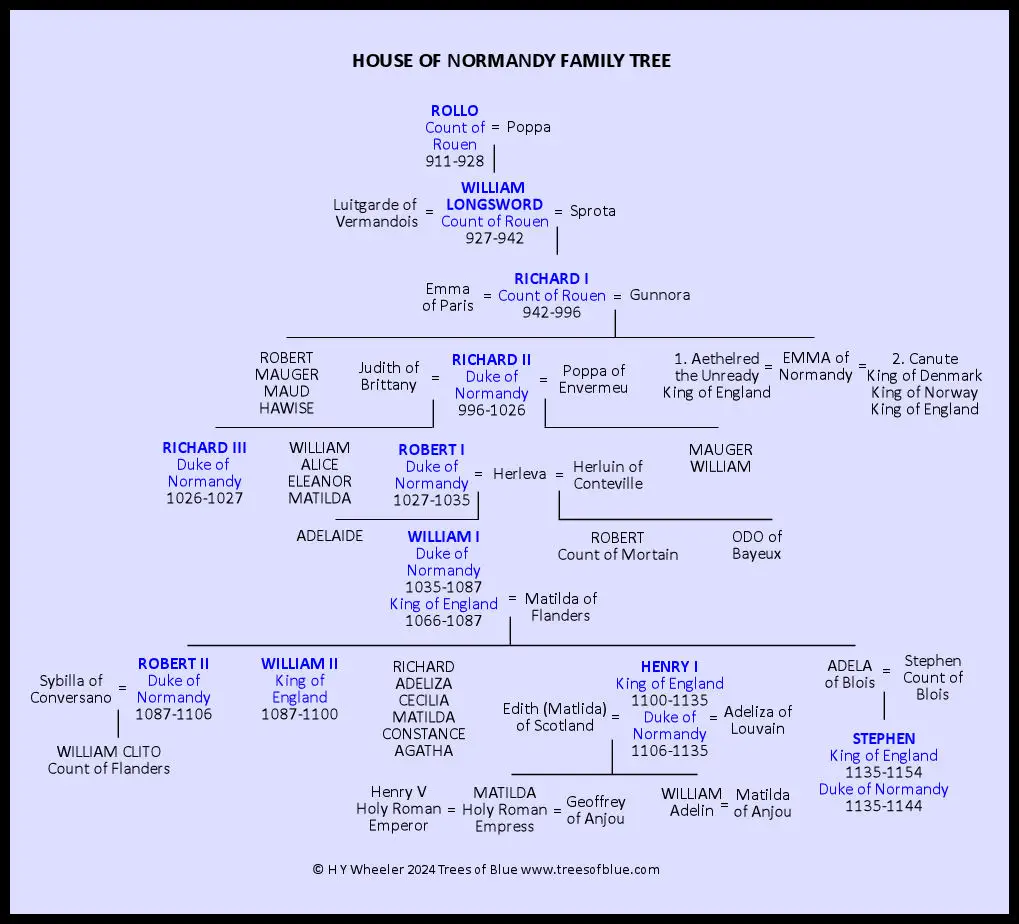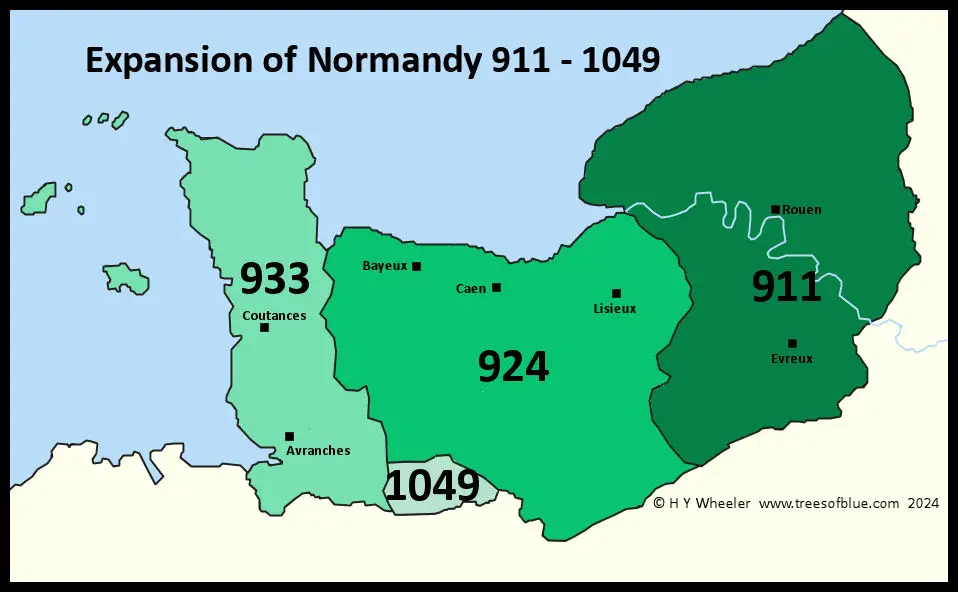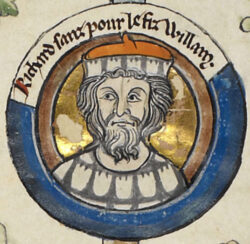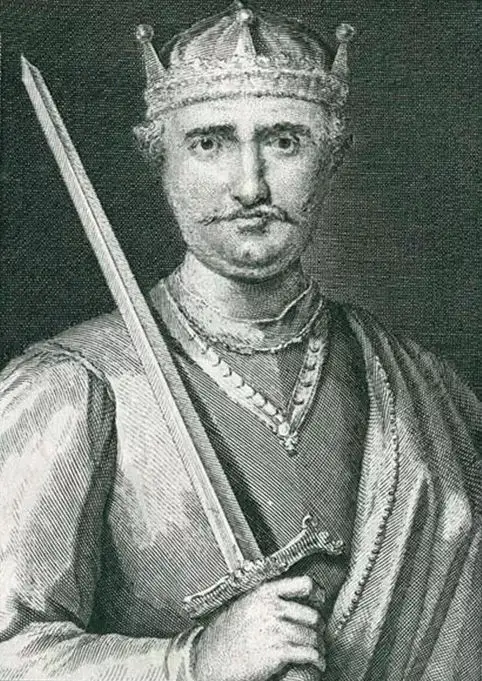The House of Normandy Family Tree shown below details all rulers of Normandy from 911 to 1144 and the Norman Kings of England from 1066 to 1154.
Rulers of Normandy are capitalized and coloured blue. Direct descendants of the House of Normandy are capitalized in black while spouses are shown in black and lower case.

What is the House of Normandy?
The House of Normandy generally refers to the royal rulers of England from 1066 to 1135. These kings were descended from the Viking Northmen, led by Rollo, who were given land in the north of France by the Frankish king Charles the Simple in 911. They and their subject are collectively known as Normans.
The first rulers of the House of Normandy were originally titled Count of Rouen but this changed to Duke of Normandy in 966.
Emma of Normandy (985-1052) first linked Normandy with England when she became the second wife of King Aethelred the Unready. She later married King Canute the Great.
The most notorious of the Normans was William Duke of Normandy (1028-1087), later dubbed William the Conqueror, who invaded England and seized the crown in 1066 ending the Anglo-Saxon period.
History of the House of Normandy
The House of Normandy traces its origins to the Viking leader Rollo, who was granted land by the Frankish king Charles the Simple in 911. This land included the mouth of the River Seine and the city of Rouen. He took the title Count of Rouen and by 924 had expanded his land west to include the important towns of Lisieux, Caen and Bayeux.

Rollo was succeeded by his son, William Longsword. In 933 Longsword recognised Raoul, King of West Frankia and in return he was granted additional land known as the Cotentin peninsula and the Channel Islands.
In 939 a dispute broke out between French barons and William’s brother-in-law Herluin II, Count of Mortain. William went to Herluin’s aid and in retaliation, Arnulf of Flanders attacked Normandy. William then attacked Arnulf’s lands destroying a number of buildings. Although a peace was signed in 941, William was assassinated by Arnulf’s men in 942.
William Longsword was succeeded by his 12 year old son, Richard. King Louis IV of West Frankia was heavily influenced by Arnulf of Flanders and immediately mounted a campaign against Normandy. Richard was taken prisoner and Normandy was divided among the King’s men. After a mob marched against King Louis IV, Richard was returned to his guardians.

In 946 Richard rode at the head of an army against King Louis IV. Richard was victorious, hostages were taken and King Louis imprisoned. Normandy was duly returned to Richard. Richard saw off further attacks on Normandy and strengthened his rule.
Richard I was succeeded by his eldest son, Richard II in 996. Richard II was the first ruler of Normandy to use the title Duke. He made alliances with Brittany and France and in 1002 married his sister, Emma, to King Aethelred the Unready of England. In 1016, after Emma married King Canute, he gave refuge to her children Edward, Alfred and Godgifu.
Richard II died in August 1026 and Richard III, his son, became the new Duke. Richard III died on 6th August 1027 having ruled for less than a year. He was succeeded by his brother Robert.
Robert I had been in conflict with his brother and many suspected him as being complicit in his brother’s death. He had a relationship with a serving girl Herleva who, in 1028, gave birth to a son, William. Robert acknowledged his son and designated him heir. Robert managed to bring a semblance of peace to Normandy and after earlier conflict with the church decided to embark on a pilgrimage in 1034. He died on the return journey.
Arguably the most famous Duke of Normandy, William II became Duke aged just 7 years old. His illegitimate status and youth led to many challenges against his rule. Three of his guardians were assassinated as rival nobles sought to gain control of the young Duke. However, they all failed and William rose to take full control of Normandy by his late teens.
He was well acquainted with his second cousin Edward, who had lived in exile in Normandy since 1016. When Edward became King of England in 1042 the two remained in contact. In 1051, after a dispute with the Godwin family, it is believed that King Edward the Confessor promised him the English throne. When Harold Godwinson took the English throne in January 1066, William planned an invasion. His success at the Battle of Hastings 1066 led to his being crowned King of England on 25th December 1066.

His early reign was difficult. The first five years were spent putting down rebellions in England and there were continual challenges to his rule in Normandy. He introduced the feudal system to England, and once it was stable, around 1075, he spent more time in Normandy than in England. In 1085 he commissioned the Domesday Survey to assess the wealth of England’s citizens, possibly with a view to exact taxation.
William died in September 1087. He left the duchy of Normandy to his eldest son, Robert Curthose, while the crown of England was inherited by his third son, William II, nicknamed Rufus. William’s early rule of England was marked by tensions between him and Robert who believed, as the eldest son, he should rule both England and Normandy.
William fell out with the church when, following the death of Archbishop Lanfranc of Canterbury, he initially refused to appoint a new Archbishop. He appointed Anselem of Bec to the position in 1093 but relations were not good and the Archbishop was exiled twice by the King.
In 1096 when Robert Curthose wished to embark on a crusade, he ceded the regency of Normandy to William II in return for a payment of 10,000 marks.
William II died while hunting in the New Forest on 2nd August 1066. His younger brother, Henry seized the treasury and was crowned King of England three days later. Henry I was a shrewd and effective ruler who managed to reunite England and Normandy under one rule, following the defeat and capture of Robert Curthose at the Battle of Tinchebrai 1066. Robert spent the rest of his life in captivity. He also forged an alliance with Germany through the marriage of his daughter, Matilda, to Henry V Holy Roman Emperor.
For all its success, Henry’s reign was also marked by tragedy. His only legitimate son and heir, William Adelin, died in the White Ship disaster of 1120, leaving Henry with no male heir. This prompted Henry to name his daughter, Matilda, as his successor, an unprecedented move for the time. Although the nobility swore to accept Matilda as Queen, when Henry died in 1135. It was his nephew, Stephen of Blois, that seized the throne.
Stephen was the son of Stephen, Count of Blois, and Adela of Normandy, daughter of William the Conqueror. His seizure of the throne was deeply resented by Matilda, now married to Geoffrey of Anjou, and descended into a civil war known as the Anarchy. By 1144 Stephen had lost the Duchy of Normandy to Geoffrey, nicknamed Plantagenet. Both sides had successes and failures and dragged on until a peace was finally agreed in 1152. Matilda would never be queen but her eldest son, Henry, would inherit the throne when Stephen died.
Stephen died in 1154 and Henry Plantagenet became King ending the rule of the House of Normandy and beginning the long rule of the House of Plantagenet. Two of Henry’s sons succeeded as Kings of England and Dukes of Normandy, Richard, nicknamed the Lionheart and John who lost Normandy to the French in 1206.
Complete list of House of Normandy
Rulers and Kings 911 – 1144
Rollo
Count of Normandy – 911-928
William Longsword
Count of Normandy – 927-942
Richard I
Count of Normandy – 942-996
Richard II
Duke of Normandy – 996-1026
Richard III
Duke of Normandy – 1026-1027
Robert I
Duke of Normandy 1027-1035
William the Conqueror
Duke of Normandy 1035-1087, King of England 1066-1087
Robert Curthose
Duke of Normandy 1087-1106
William II (Rufus)
King of England 1087-1100
Henry I
Duke of Normandy 1106-1135, King of England 1100-1135
Stephen of Blois
Duke of Normandy 1135-1144, King of England 1135-1154
Published Sept 24 2024 – Updated – Dec 16 2024
Harvard Reference for House of Normandy Family Tree:
Heather Y Wheeler. (2024 – 2025). House of Normandy Family Tree 911 – 1154. Available: https://www.treesofblue.com/house-of-normandy-family-tree-911-1154. Last accessed April 15th, 2025
